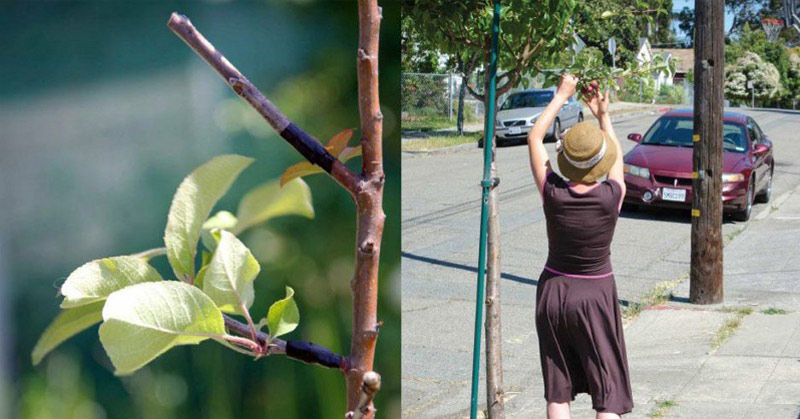The Guerrilla Grafters are a group that was launched in 2011. Their mission is to secretly—and illegally—graft fruit-bearing branches onto decorative trees that line city streets. Their goal? To help build a better and more nourishing environment in every neighborhood. To them, every sterile decorative tree is viewed as a missed opportunity to provide free fresh fruit to people, which can be particularly helpful for homeless folk.
Many urban planners specifically avoid planting fruit trees since multitudes of flowering fruits would cause a mess on the streets once they ripen and fall. As much as fruit trees are considered an annoying mess that are magnets for insects and vermin, this rebel group considers them as a way to revolutionize sustainability and provide healthy food for passersby. [1]
“Just taking an evening stroll, and then you see a fruit and you reach over and now you’re nourished,” says grafter Tara Hui.
The grafting method is fairly simple. They take a healthy branch from a fruit tree, insert it into a cut onto the sterile tree, and secure the branch with tape. Then nature does the rest. After the branch heals, it will grow as a part of its new host. After each grafting, locals volunteer to care for the tree, its harvesting, and preventing pests and messes.
The slogan of the Guerilla Grafters is to transform the “city streets into food forests, and unravel civilization one branch at a time.” Although their agricultural vigilantism is illegal, many people can get behind their cause to make fresh and healthy produce available for citizens. [2]
Read: Mountain Where Soil Is ‘90% Gold’ Discovered Causing Big Gold Rush
A firsthand experience of grafting fruit trees
Ilana Strauss joined a group of guerilla gardeners in New York City and documented her first experience grafting on Tree Hugger. She explains the cities plant trees to keep temperatures stable, clean the air, and decorate what would otherwise look like a stale, concrete street.
“These city trees tend to be decorative—they don’t bear fruit—and some people think that’s a waste. There are so many hungry people in cities; why not plant fruit-bearing trees? Whole cities could be lined with free apples and peaches,” she writes.
“So people take this issue into their own hands by turning decorative trees into fruit-bearing trees. These folks are called guerilla grafters. And I joined them on one of their expeditions.”
Strauss was among about six others when she was taught how to graft. Then the group took the branches wrapped in damp paper towels and embarked onto the Brooklyn streets. Despite the illicit behavior, they worked in broad daylight during the afternoon.
They trekked to a row of ornamental cherry trees, bred specifically not to bear fruit. They appreciated the irony of grafting peach branches onto a cherry tree.
“I slid the peach branch into the cherry branch. Then I covered the branches in wax, taped them up, and wrapped a rubber band around them. Down the line, maybe someone would enjoy free peaches. Take that, agribusiness.
“So if you’re ever wandering through Brooklyn and notice a peach growing out of a cherry tree, you’ll know what went down.” [3]
Hui grafts in the Bay Area with her two assistants. Her experience planting fertile pear branches onto a line of sterile pear trees was reported on NPR.
“We don’t have a supermarket and we have very few produce stores [here],” she says. “What better to alleviate scarcity of healthy produce in an impoverished area than to grow them yourself and to have it available for free.” [4]
The law is fighting Guerilla Grafters
As good-hearted as this type of ‘vandalism’ may be, it’s still considered vandalism and the police haven’t been pleased. Officials at the Public Works Department have declared that the trees are city property and it’s unacceptable to graft them. They hold that ripe fruit falling in the streets can become hazard and attract rodents.
Carla Short is an urban forester for the San Francisco Department of Public Works and in charge of 103,000 public trees. She’s opposed to these rebel grafters.
“It gets very dangerous very quickly,” Short says. “I mean the minute that fruit gets crushed on the sidewalk, it is slippery. We certainly don’t want people to get injured.” She adds that fruit trees are not illegal everywhere and they are encouraged in community gardens.
“The City considers vandalism a serious offense,” says Public Works Director Mohammed Nuru. “There would be fines for damage to city property.” Nuru reminds readers that anyone interested in urban agriculture could contact the City to discuss suggestions. [5]
So if you’re walking around San Francisco or New York and spot a single tree branch bearing fruit, you may be witnessing the results of a grafter. Take a fruit and enjoy! It’s for you.
While the majority of media coverage on The Guerilla Grafters fell between 2012 and 2015, they are still active on social media. It is unclear if they are still on the streets grafting today. We hope their efforts have not been fruitless.
Keep Reading: Why Did Norwegian Teachers Wear Paper Clips During World War II?
Sources
- “Activists Covertly Grafting Fruit Branches Onto Decorative Trees In San Francisco.” CBS. Megan Goldsby. November 2, 2015
- “Guerrilla Grafters go out on a limb.” SFGate. Tom Levy. August 27, 2012
- “I joined a guerilla mission to turn city trees into fruit trees.” Tree Hugger. Ilana Strauss. May 21, 2018
- “Guerrilla Grafters Bring Forbidden Fruit Back To City Trees.” NPR. Lonny Shavelson. April 7, 2012
- “Guerilla Grafters Secretly Splicing San Francisco Trees With Fruit-Bearing Branches.” HuffPost. Robin Wilkey. January 4, 2012
- Guerilla Grafters. Accessed: June 1, 2020

